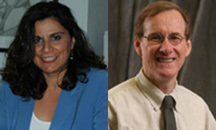
Two University of Notre Dame faculty members have been named fellows of the American Association for the Advancement of Science (AAAS) in honor of their scientifically or socially distinguished efforts to advance science or its applications.
AAAS, founded in 1848 as a nonprofit association, is the world’s largest scientific society and the publisher of the prestigious journal Science. The new Notre Dame AAAS fellows are: Ani Aprahamian, professor of physics, and James J. McKenna, Rev. Edmund P. Joyce Chair in Anthropology.
Aprahamian, a member of the Notre Dame faculty since 1989, was cited for"distinguished contributions to understanding the structure of atomic nuclei and the origin of elements and for communicating the excitement of science to diverse audiences."
McKenna, who joined the Notre Dame faculty in 1997, was cited for"distinguished contributions to our understanding of mother-infant behavior and health and their influence on the causes of Sudden Infant Death Syndrome."
Aprahamian’s research is aimed at gaining an understanding of the origin of the elements of the universe. In her laboratory, she attempts to duplicate the nuclear processes in the universe that control stellar evolution, trigger supernova events, and lead to thermonuclear explosions observed as novae and X-ray bursts.
Aprahamian previously served as director of the nuclear structure laboratory at Notre Dame, which is the longest continuously funded research effort at the University.
She also was instrumental in gaining a $10 million grant from the National Science Foundation to establish a physics frontier center at Notre Dame named JINAThe Joint Institute for Nuclear Astrophysicsa collaborative effort between researchers at Notre Dame, Michigan State University and the University of Chicago. The institute joins together the research efforts in separate disciplines ranging from astronomy to astrophysics to nuclear physics to study the broad range of nuclear processes in the universe.
A fellow of the American Physical Society, Aprahamian is chair of the scientific council of GANIL, a prominent nuclear physics laboratory in France. She has served as program director for nuclear physics and nuclear astrophysics at the National Science Foundation for the past two years and is currently co-chairing the study for the use of isotopes in the U.S. for applications as broad as medicine, the environment and homeland security.
Aprahamian served as physics department chair from 2003 to 2005 and the number of physics majors tripled during her tenure.
She earned her bachelor’s and doctoral degrees from Clark University.
McKenna is director of Notre Dame’s Mother-Baby Behavioral Sleep Laboratory and a world-renowned expert of infant co-sleeping, breast-feeding and sudden infant death syndrome (SIDS).
McKenna pioneered the first behavioral and electro-physiological studies documenting differences between mothers and infants sleeping together and apart and has become known worldwide for his work in promoting studies of breast feeding and mother-infant co-sleeping. His research continues to build evidence in favor of the notion that babies sleep best and more safely next to their mothers, within sensory range.
McKenna has been awarded the prestigious Shannon Award from the National Institutes of Child Health and Development for his SIDS research. His two most recent co-edited books are"Evolutionary Medicine"and"Evolutionary Medicine and Health: New Perspectives.“In 2007, he authored a parenting book for a popular audience titled”Sleeping With Baby: A Parent’s Guide to Co-Sleeping."He has published more than 130 scientific papers on infant sleep and SIDS, is regularly interviewed in the national media on issues relating to his research, and is a sought-after speaker at medical, parenting and policy conferences worldwide.
McKenna earned his doctorate from the University of Oregon and taught at Pomona College in California and the University of California, Berkeley, before coming to Notre Dame in 1997.
The tradition of AAAS fellows began in 1874 and this year the association is honoring 486 individuals as fellows. Currently, members can be considered for the rank of fellow if nominated by the steering groups of the association’s 24 sections or by any three fellows who are current AAAS members (so long as two of the three sponsors are not affiliated with the nominee’s institution) or by the AAAS executive officer.
Aprahamian and McKenna will be presented with an official certificate and a gold and blue (representing science and engineering, respectively) rosette pin on Feb. 14 at the Fellows Forum during the 2009 AAAS annual meeting in Chicago.
TopicID: 30866